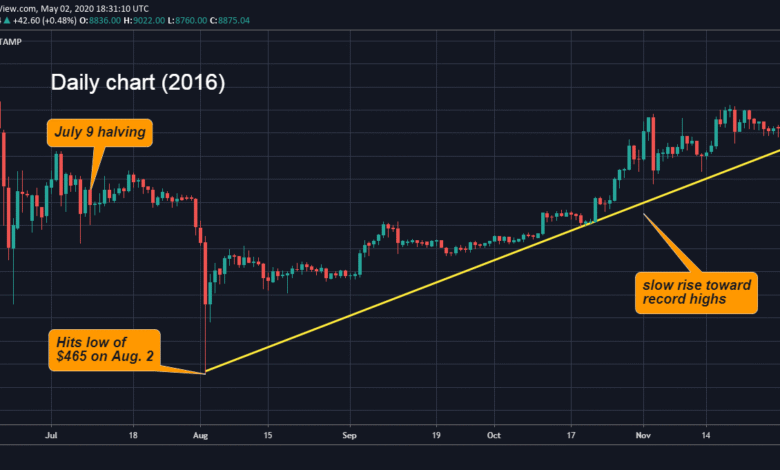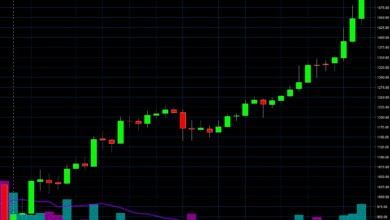Bitcoin Price Drop: Market Recoil After Inflation Shock

Bitcoin price drop reached alarming levels this Thursday morning, as the cryptocurrency market struggled to make sense of shocking inflation data released by the U.S. Bureau of Labor Statistics. Following a stunning surge in the Producer Price Index, which skyrocketed by 0.9%, investors were left reeling, leading to a stark decline in Bitcoin’s value. In the wake of this news, Bitcoin plummeted from over $122,000 to $117,000, mirroring a broader downturn that impacted various asset classes. This significant price drop raises questions about the inflation data effect on digital assets and its contribution to a cryptocurrency market decline. Investors eyeing the potential implications of Bitcoin inflation impact may be concerned as markets adjust to the PPI Bitcoin reaction, reshaping expectations moving forward.
As the cryptocurrency landscape faces fresh challenges, the recent downturn in Bitcoin prices has sparked widespread discussion among analysts and enthusiasts alike. This unexpected decrease in value can be attributed to the latest inflation metrics that have sent shockwaves through financial markets. With record highs reported in inflation indicators such as the Producer Price Index, many are left wondering how these economic factors will influence the future of digital currencies. The ripple effect from this inflation data is being felt by other cryptocurrencies, highlighting a significant shift in market sentiment. As we delve deeper into the ramifications of this crisis, it’s essential to understand how such economic indicators shape the volatile world of blockchain assets.
Economic Impact of Inflation on Bitcoin Prices
The recent surge in the Producer Price Index (PPI) has left a lasting impression across the cryptocurrency landscape, particularly impacting Bitcoin prices. As inflation concerns take center stage, investors are increasingly wary. The PPI, indicating substantial growth at wholesale levels, signals potential future rises in consumer prices, which has spurred a sell-off in Bitcoin and other digital currencies. The shift in investor sentiment reflects a deeper anxiety about inflation’s effect on purchasing power and overall market stability, essential factors that can dictate the future trajectory of Bitcoin prices.
Moreover, the repercussions of inflation impact Bitcoin not just as a speculative asset but as a hedge against traditional economic downturns. As inflation data pulses through the markets, Bitcoin’s behavior mirrors that of traditional commodities like gold, as investors search for shelter from depreciating fiat currencies. However, this relationship can sometimes amplify volatility; hence, while some view Bitcoin as a safeguard against inflation, others view this turbulent moment as a crucial inflection point for the cryptocurrency’s acceptance as a stable asset.
Bitcoin Price Drop: The Aftermath of Rising Inflation
Following the release of unsettling inflation data, Bitcoin saw a drastic price drop from over $122,000 to approximately $117,000. Such steep declines can significantly reshape trading strategies and investor behaviors. The surge in the PPI indicates a broader trend of rising prices, which many fear could lead to more aggressive policies from the Federal Reserve, further complicating the economic landscape for cryptocurrencies. Consequently, investors are reassessing their positions, prompting massive liquidations and a heightened sense of uncertainty in the market.
In light of this reality, traders reacted quickly, driving down Bitcoin’s market capitalization and disrupting its upward momentum. The slump exemplifies the relationship between inflation data and the cryptocurrency market’s immediate response. As the inflation narrative unfolds, traders should remain vigilant, analyzing the trends in both PPI and Bitcoin’s market behavior to anticipate future price movements. This interconnectedness underlines the crucial role macroeconomic indicators play in shaping cryptocurrency dynamics.
Understanding the Producer Price Index and Bitcoin
The Producer Price Index (PPI) serves as a pivotal economic indicator reflecting inflation directly from the perspective of producers. When the PPI rises significantly, it foreshadows potential increases in consumer prices, stirring concerns about long-term inflationary pressures. Such data can lead to widespread retrenchment in speculative markets, including cryptocurrency, as traders pivot from riskier assets to more stable investments. Understanding how Bitcoin reacts to these economic signals is essential for traders navigating this volatile market.
Moreover, Bitcoin’s sharp reactions to PPI data reveal its sensitivity to macroeconomic indicators. The anticipation surrounding PPI announcements can cause speculative trading, often leading to drastic shifts in pricing. As such, Bitcoin’s relationship with the PPI not only reflects its volatility but also highlights its potential to act as a barometer for broader economic trends. Traders who closely monitor the PPI are often more equipped to make informed decisions amidst the crypto market’s sudden swings.
The Broader Cryptocurrency Market Decline
Following Bitcoin’s recent price drop, the broader cryptocurrency market has mirrored these trends, experiencing a decline fueled by inflation fears. Price drops in leading cryptocurrencies like Ether underscore the notion that Bitcoin often sets the market tone; when Bitcoin falters, other digital assets tend to follow. This correlation is critical for traders aiming to navigate the waves of market sentiment that can lead to rapid price swings.
As cryptocurrencies tread water amid inflation concerns, the decline signals a moment of reckoning for the sector, challenging its growth narrative. Many crypto enthusiasts originally viewed these digital assets as a hedge against inflation, but recent market actions suggest a reevaluation of that perceived safety. Investors are now pressured to analyze not just price action but also the underlying economic factors that can influence their portfolios in an increasingly interconnected financial landscape.
The Effect of Inflation Data on Market Volatility
Inflation data, particularly when unexpectedly high, can induce significant market volatility. In markets laden with speculation, like cryptocurrencies, quick reactions based on newly released data points can lead to increased liquidations and sharp price fluctuations, as evidenced by Bitcoin’s recent slide. Expectations play a central role; when actual inflation metrics surpass forecasts, irrational panic can ripple through investor psychology, exacerbating market conditions.
Understanding the underlying causes of this volatility is crucial for both seasoned and amateur investors. When inflationary pressures signal potential tightening of monetary policy, assets perceived as high-risk, such as Bitcoin, often suffer the most. However, this dynamic can also provide opportunities for shrewd traders who are adept at reading market trends in times of upheaval. By recognizing the interplay between inflation data and market psychology, investors can position themselves to mitigate risks during periods of increased volatility.
Strategies for Managing Bitcoin Investments During Inflationary Times
In light of rising inflation and its impact on Bitcoin prices, investors need to develop robust strategies to safeguard their investments. Diversification remains a key tactic; maintaining a balanced portfolio that includes different asset classes can help cushion against the excessive volatility often associated with cryptocurrencies. Moreover, hedging strategies involving options or futures can provide additional protection against unforeseen market downturns, especially during inflationary periods that threaten market stability.
Additionally, staying informed about economic indicators such as the PPI can empower investors to make timely decisions. By understanding how these metrics influence market sentiment and price movements, traders can act proactively rather than reactively. Knowledge is power in the volatile world of cryptocurrencies. By keeping a close eye on economic developments and adjusting strategies accordingly, investors can not only survive but potentially thrive even amid inflation-induced market turmoil.
The Long-term View of Bitcoin Amidst Inflation
Despite the turbulence it faces, Bitcoin has persisted as a long-term investment for many, rooted in the belief that digital currencies will ultimately supersede traditional financial systems. As inflation continues to challenge fiat currencies, advocates argue that Bitcoin’s scarcity offers a compelling case for preservation of wealth. This perspective has shifted some investors’ outlooks, focusing on Bitcoin as a potential safe haven in an inflationary landscape, despite its short-term volatility.
Ultimately, the long-term view of Bitcoin amid inflationary pressures hinges on a combination of macroeconomic trends, regulatory decisions, and community adoption. Investors who maintain a focus on these broader trends, rather than being swayed by daily market fluctuations, may find opportunities for significant returns. As inflation analytics evolve, so too will the role of Bitcoin, emphasizing the importance of patience and strategy in a continuously shifting economic realm.
Investor Sentiment and Bitcoin Reactions to Inflation Figures
Investor sentiment plays a crucial role in Bitcoin’s response to inflation figures. As data is released, the prevailing mood among traders can heavily influence market direction. For instance, high inflation metrics tend to incite fear—that the central bank might take steps to curb inflation by raising interest rates. This fear can lead to panic selling, as seen in the aftermath of the recent PPI release.
Conversely, a more optimistic outlook can lead to bullish behavior, as traders might interpret stabilization in inflation as a potential for Bitcoin to regain its upward momentum. The emotional response among investors can often be more potent than the data itself in driving price changes. Recognizing and managing this sentiment offers traders vital insights in navigating Bitcoin’s often unpredictable market responses.
Future Trends: Bitcoin’s Path in an Inflationary Economy
Looking ahead, the trajectory of Bitcoin will significantly depend on how well it can adapt to ongoing inflationary pressures. As traditional markets recalibrate in response to changing economic conditions, Bitcoin must find its place in this evolving landscape. The potential for mainstream adoption as an inflation hedge hinges upon greater security and stability in its price movements over time, alongside regulatory clarity surrounding cryptocurrencies.
As inflation remains a key concern for both individual and institutional investors, Bitcoin’s narrative will continue to evolve. The adoption of advanced technologies and innovative trading practices will also shape Bitcoin’s role within the global economy. Understanding these future trends will be essential for those looking to invest in Bitcoin while considering the ramifications of inflation in the broader economic context.
Frequently Asked Questions
What caused the recent Bitcoin price drop?
The recent Bitcoin price drop can be attributed to the release of unexpectedly high inflation data by the U.S. Bureau of Labor Statistics. Following the announcement, Bitcoin’s price fell significantly due to market reactions to the Producer Price Index (PPI) indicating a sharp rise in wholesale inflation.
How does inflation data affect Bitcoin prices?
Inflation data, particularly metrics like the Producer Price Index (PPI), can significantly impact Bitcoin prices. When inflation rates are higher than expected, like the recent surge of 0.9% in the PPI, it creates uncertainty in the markets, leading to declines in cryptocurrencies, including Bitcoin.
What is the relationship between Bitcoin and the cryptocurrency market decline after inflation data is released?
Bitcoin often reacts strongly to broader cryptocurrency market declines, especially when accompanied by negative inflation data. The recent inflation numbers triggered a decline in Bitcoin as the market anticipated tight monetary policy, resulting in both the digital asset and other cryptocurrencies dropping in value.
Why did Bitcoin drop below $118,000 after inflation data was released?
Bitcoin dropped below $118,000 primarily due to panic selling following the inflation data release. The unexpected rise in the Producer Price Index led investors to fear worsening economic conditions, causing a rapid sell-off across the cryptocurrency market.
What impact does the Producer Price Index (PPI) have on Bitcoin and cryptocurrency prices?
The Producer Price Index (PPI) serves as an early indicator of inflation and can greatly influence Bitcoin prices. When PPI figures exceed expectations, as they did recently, it often results in a decline in Bitcoin and other cryptocurrencies, reflecting investor concerns about inflationary pressures that may impact the market.
How do Bitcoin and Ether prices respond to inflationary pressures like the recent PPI increase?
Both Bitcoin and Ether prices typically decline in response to inflationary pressures indicated by metrics like the PPI. The recent increase in the PPI contributed to a drop in Bitcoin’s value, as uncertainty about economic stability drove market sentiment bearish.
Can future inflation data lead to further Bitcoin price drops?
Yes, future inflation data could potentially lead to further Bitcoin price drops if it continues to indicate rising inflation. Investors closely monitor inflation metrics, and any continuation of high PPI readings could trigger more volatility in Bitcoin prices.
What was the Bitcoin price fluctuation after the inflation data release?
After the release of the inflation data, Bitcoin experienced significant price fluctuation, dropping to around $117,000 from over $122,000 just a day prior. This rapid change reflects the immediate market reaction to the unexpected inflation metrics.
| Key Point | Details |
|---|---|
| Bitcoin Price Reaction | Bitcoin dropped significantly from over $122,000 to $117,000 shortly after inflation data release. |
| Inflation Data Released | U.S. Producer Price Index (PPI) showed a 0.9% increase, exceeding expectations and indicating potential inflation risks. |
| Market Overview | Overall crypto market experienced downturns; Ether (ETH) also fell by 3.5%. |
| Trading Statistics | Bitcoin’s trading volume increased by over 30% to $108.16 billion; market cap fell by 3.09% to around $2.34 trillion. |
| Future Predictions | Economists predict rampant inflation based on PPI data, affecting market sentiment across all sectors. |
| Liquidations and Losses | Bitcoin futures saw liquidations of over $225 million, with bulls losing $159 million due to the unexpected data. |
Summary
The recent Bitcoin price drop is attributed to the release of alarming inflation metrics by the U.S. Bureau of Labor Statistics. As a result, Bitcoin saw a significant decline, mirroring the overall market’s reaction to these economic indicators. Investors are now looking closely at ongoing inflation trends, as they will likely influence Bitcoin’s future performance and market behavior.




